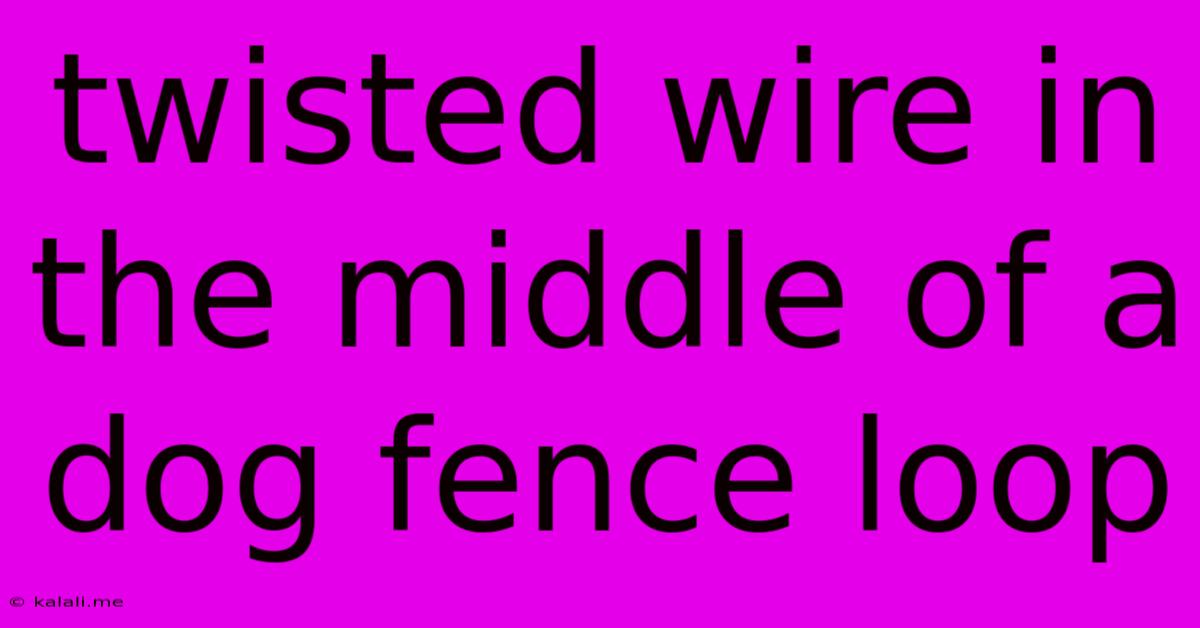Twisted Wire In The Middle Of A Dog Fence Loop
Kalali
Jun 04, 2025 · 3 min read

Table of Contents
Twisted Wire in the Middle of a Dog Fence Loop: Troubleshooting and Solutions
Finding a twisted wire in the middle of your dog fence loop is frustrating, especially when your furry friend is trying to escape or the system isn't working as it should. This problem can stem from several issues, from simple accidental kinks to more serious damage. This guide will walk you through troubleshooting this common dog fence problem and provide solutions for getting your system back up and running safely and effectively.
Understanding the Problem: A twisted wire disrupts the electrical signal that your dog fence relies on to deliver a correction. This interruption can lead to inconsistent performance, allowing your dog to escape unnoticed or even experiencing no correction at all. The location of the twist – right in the middle of the loop – makes it challenging to pinpoint the exact source of the problem, so systematic troubleshooting is key.
Common Causes of Twisted Wire in Dog Fence Loops:
- Accidental Damage: This is the most frequent cause. Your dog might have playfully tugged on the wire, a lawnmower could have run over it, or even a landscaping project might have inadvertently damaged it.
- Animal Interference: Other animals, like rodents or squirrels, may chew on the wire, causing twists and breaks. This is especially common in areas with dense vegetation.
- Ground Movement: Freezing and thawing cycles, or shifting soil, can put stress on the wire, leading to kinks and twists over time.
- Poor Installation: If the wire wasn't properly secured during installation, it's more susceptible to twisting and damage from external forces.
Troubleshooting Steps:
-
Visual Inspection: Begin by thoroughly inspecting the entire loop, paying close attention to the area where you suspect the problem lies. Look for obvious kinks, breaks, or areas where the wire is significantly damaged or twisted. Check both sides of the wire and beneath any vegetation or debris.
-
Testing the Signal: Most dog fence systems have a signal tester. Use this tool to systematically check the wire's conductivity along the entire loop. This will pinpoint the exact location of the break or significant signal disruption, even if the twist isn't immediately visible. Pay attention to voltage fluctuations; a drastic drop indicates the problem area.
-
Identify the Severity: Once you've located the problem, assess the damage. A simple kink might be easily straightened, while a severe twist or break requires more extensive repair.
Repairing the Twisted Wire:
-
Minor Kinks: For minor kinks, carefully straighten the wire by hand. Ensure you don't pull too hard, as this could damage the wire further.
-
Moderate Twists: For more significant twists, you may need to use pliers to carefully untwist the wire. Be gentle to avoid breaking the wire. Always work with the wire lying flat; avoid twisting it while it's taut.
-
Severe Damage or Breaks: If the wire is severely damaged or broken, you'll need to replace the section. This requires cutting out the damaged portion, and using wire connectors to splice in a new section of wire, ensuring proper electrical connection and insulation. Always use wire designed specifically for dog fence systems.
-
Burying the Wire: Once repaired, ensure the wire is properly buried and secure, preventing future damage.
Preventative Measures:
- Regular Inspection: Regularly inspect your dog fence wire for any signs of damage. This proactive approach can prevent minor issues from escalating into major problems.
- Proper Burial Depth: Make sure the wire is buried deeply enough to protect it from accidental damage and exposure to the elements.
- Secure Installation: Ensure the wire is securely fastened during installation to minimize the risk of displacement.
- Keep the Area Clear: Keep the area around the wire clear of debris and vegetation to prevent damage and interference.
By following these troubleshooting steps and preventative measures, you can effectively address a twisted wire in your dog fence loop, ensuring your pet's safety and the continued effectiveness of your containment system. Remember safety first! If you are uncomfortable performing these repairs yourself, consult a professional dog fence installer.
Latest Posts
Latest Posts
-
Connect Sposervice No Valid Oauth 2 0 Authentication Session Exists
Jun 06, 2025
-
Is There Work Done By The Lorentz Force
Jun 06, 2025
-
Standard Height Closet Shelf And Rod
Jun 06, 2025
-
What Insulation Do I Use In Showers
Jun 06, 2025
-
What Blood Type Does Jesus Have
Jun 06, 2025
Related Post
Thank you for visiting our website which covers about Twisted Wire In The Middle Of A Dog Fence Loop . We hope the information provided has been useful to you. Feel free to contact us if you have any questions or need further assistance. See you next time and don't miss to bookmark.